The Nissan Leaf is by far the highest-volume electric car ever sold, with total sales now having passed 250,000 units.
First launched in 2011, the Leaf got some updates for the 2013 model when production for North American sales moved from Oppama, Japan, to Smyrna, Tennessee.
It got a battery capacity upgrade for 2016, boosting its rated range from 84 to 107 miles. That aside, the Leaf has pretty much stayed the same for seven years.
DON'T MISS: New 2018 Nissan Leaf: More Details On New Styling, Range (May 2014)
We know an all-new, second-generation Leaf model is coming sometime soon.
At first, we'd expected it to be a 2016 model—in parallel with the second-generation Chevrolet Volt introduced that year—but a new Leaf didn't appear in 2016.
Or in 2017.
So here's what we know so far about what we're now calling the 2018 Nissan Leaf electric car.

Nissan Sway Concept - 2015 Geneva Motor Show live photos
This information is gathered from industry sources, Nissan executives, off-the-record chats with people who work with Nissan, and media reports from around the world.
DESIGN
The styling of the 2011 Leaf was certainly distinctive, but it was also polarizing.
In form, today's Leaf is an upright five-door hatchback that's either a large compact or a small mid-size car, depending on how you measure.
ALSO SEE: Nissan Sway Concept Sets The Look For Future Small Cars—And Leaf?
But the details—the rounded ends, the very long lights topped with little fins that stretched to the base of the windshield, and a Space Age-y interior—added up to a car that some loved but others clearly disliked.
Discussions since then have indicated that the next Leaf may be somewhat more conventional in appearance.
One possible indicator of styling direction is the Nissan Sway concept unveiled in March 2015 at the Geneva Motor Show, which the company said pointed toward its future small-car design language.

Nissan Sway Concept
While widely presumed to be a lightly disguised version of the next Micra minicar, the five-door hatchback concept is a bit larger than that.
We suspect it has elements that will show up in the 2018 Nissan Leaf, or at least point in that direction.
Nissan design chief and senior vice president Shiro Nakamura said in the fall of 2014 that to expand the next Leaf's appeal into a larger market—beyond early adopters—would require to be be a nice-looking car.
RELATED: 2018 Nissan Leaf: Will Less 'EVness' Make It More Appealing? (Oct 2014)
Then, he said, designers could add more 'spice' in the design for those buyers who might want it—rather than starting with specific design traits that label the vehicle an electric car.
The next Leaf won't necessarily be more conservative, Nakamura argued during an interview at the Paris Motor Show, but simply a very stable, nicely-proportioned car.
And for buyers who want to emphasize the Leaf's electric-car nature, there will be trim, lamps, or gauges that do that if desired.

Lithium-ion battery pack of 2011 Nissan Leaf, showing cells assembled into modules
BATTERY RANGE
Perhaps the single most important facet of the 2018 Leaf will be its rated range, or the different ranges offered if there are multiple battery-size options.
Three years ago, Andy Palmer—who then headed Nissan product development—suggested that the next Leaf would have a range of perhaps 120 miles, possibly as high as 150 miles.
And he strongly hinted that the car might offer a range of battery options at different prices.
MORE: Nissan Leaf Likely To Offer Larger Battery For Longer Range (Apr 2014)
We expect the base model of the next Leaf to offer a range of about 120 miles, a slight increase on the 107 miles of the updated 2016 first-generation Leaf.
But with last month's launch of the Chevrolet Bolt EV, EPA-rated at 238 miles, Nissan knows it has to offer a version of the next Leaf with a U.S. rating of 200 or more miles.
(Some confusion occurs when Nissan executives, discussing projected range, fail to make it clear whether they're referring to tests conducted on the gentler Asian or European test cycle or the more demanding U.S. EPA cycle. The U.S. tests are viewed as producing lower but more realistic range ratings.)
Knowledge of battery chemistry, production technology, and management strategies has progressed considerably since 2009 and 2010, when the specs for the first Leaf battery were frozen.

Nissan Sway Concept - 2015 Geneva Motor Show live photos
The 2013 update boosted range from 73 miles to 84 miles (using a slightly different set of test parameters).
Three years later, the pack capacity increased for 2016 by 25 percent (from 24 kwh to 30 kwh) for a boost to 107 miles combined.
Ranges of 120 to 200 miles would likely make the Leaf a more viable alternative for some buyers who felt 70 to 85 miles was too little to accommodate their needs.
Until that happens, however, the current Leaf will face formidable competition from the Bolt EV, another five-door hatchback with slightly more interior volume and more than twice the Leaf's range.
Nissan CEO Carlos Ghosn confirmed a model with 200 miles or more of range in comments at the Consumer Electronics Show held in January 2017 in Las Vegas.
He also noted that the new Leaf will come with Nissan's ProPilot technology, which permits the car to drive itself autonomously within a highway under certain circumstances.

Nissan Sway Concept - 2015 Geneva Motor Show live photos
BATTERY CELL SUPPLIER
Since the Leaf launched, Nissan has produced its own lithium-ion cells through its joint venture with NEC, known as Automotive Electric Supply Corporation or AESC.
But the company's alliance partner, the French maker Renault, has also used cells from leading producer LG Chem in its own lineup of battery-electric vehicles.
LG Chem not only supplies cells to the Chevrolet Bolt EV, it has supply contracts with more than a dozen other global brands across the globe.
Reports over the last three years indicate that Nissan has wrestled with sourcing cells from LG Chem versus its own partially-owned supplier.
It's possible that different battery options may use different cell suppliers. But it's widely expected that at least some Leafs will switch to LG Chem cells.
Now that technical specs are out for the 2016 Chevrolet Volt, the 2016 Toyota Prius, the 2017 Chevrolet Bolt EV, and the 2017 Toyota Prius Prime plug-in hybrid, the second-generation Leaf is the last member of that debut class missing in action.

Nissan Sway Concept - 2015 Geneva Motor Show live photos
We'd initially expected the 2018 Leaf to appear sometime last year as a 2017 model, but as New Year's Day 2017 rolled around, there was no sign of it.
The first-generation Leaf is thus dutifully enduring a full seven-year model cycle, with sales falling and not a hint of information about its successor.
That could possible be due to the quick two-year timeframe between the announcement of the Chevy Bolt concept car and the first sales of the Bolt EV.
It's not unreasonable to think that the quick announcement and launch of the Bolt EV threw a monkey wrench into Nissan's launch planning just as it locked in a second-generation Leaf—with a 150-mile range.
In any case, sooner or later we'll see the next Leaf. We're still betting it'll be sometime this year. Fingers crossed.
_______________________________________













